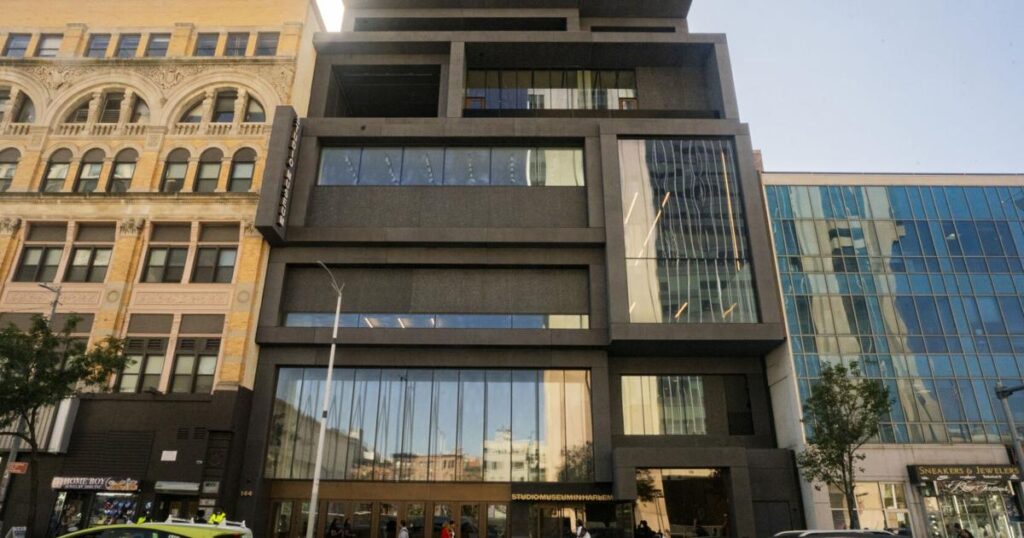**The Studio Museum in Harlem: A Bold New Chapter on 125th Street**
NEW YORK — The new Studio Museum in Harlem is unmissable on West 125th Street. Charcoal and gray, its jumbled façade of sculptured, stacked niches and window frames is poised like a Mondrian. Facing off the towering, broad-shouldered Adam Clayton Powell Jr. State Office Building, the museum holds its own. Its grays and blacks, both matte and polished, shift in the changing light, making the building itself an architectural essay on varieties of blackness in precast concrete and polished aggregate.
Founded in 1968 by a group of artists and philanthropists, the Studio Museum started in a loft above a liquor store. In the early ‘80s, it moved into a former bank with Depression-era wiring and no air conditioning. J. Max Bond Jr., the esteemed Black architect and Harlem resident, performed miracles on a shoestring, retrofitting the bank’s interior. The museum showcased groundbreaking exhibitions but, like so many Black institutions in Harlem, had to make do with its improvisatory architecture.
The new $160 million building is a transformation. Rising seven stories where the bank was demolished, the museum now doubles its exhibition space. Custom-built classrooms for school groups, studios for resident artists, a library, and a soaring lobby with a monumental staircase—all serve as the building’s circulatory and social spine. Community organization rooms and a roof garden, designed by Harlem’s Studio Zewde, offer views north to the South Bronx and south to midtown’s skyline of supertall towers. Up there, the museum feels like the city’s center.
Construction was delayed by the pandemic, stretching the project to seven years. A scandal involving the lead architect, David Adjaye, who left after allegations reported in The Financial Times, put the museum and design team in a scramble. For its price tag and ambition, the project matched efforts typically seen only in much wealthier institutions. The Studio Museum had just $10 million in reserves and no endowment when the project began. Thanks to a capital campaign led by director Thelma Golden—an art world force—the museum raised $307 million, an extraordinary feat for a small cultural organization. This kept the museum’s operations and exhibitions afloat during construction and established a $23 million cash reserve and a $52 million endowment to ensure financial security moving forward.
Now, the building is finally opening on Saturday. It’s a remarkable accomplishment and an uplifting, uncompromising addition to the city’s civic landscape. Its opening comes as 125th Street undergoes ongoing transformation. The National Black Theater is moving into a new mixed-use tower; the Apollo Theater is undergoing a major renovation and has recently taken over the Victoria Theater, next door to new luxury hotels and affordable housing. Across the street from the Studio Museum, the Urban League Empowerment Center combines new offices, subsidized housing, a civil rights museum, Trader Joe’s, and Target—all unimaginable in the 1960s, when Harlem was in decline.
Back then, officials promised jobs to Harlemites by demolishing the entire north side of 125th Street for the state office building. Protesters occupied the area, demanding that Black residents—not upstate politicians—shape Harlem’s future. They erected a tent village with a field kitchen, clinic, and daycare—a forerunner of Occupy Wall Street’s encampments. Renamed “Reclamation Site No. 1,” the occupation ended with police evictions, but the movement for self-determination continued.
A coalition of church leaders, bankers, and community members picked up where the protesters left off. They believed Black self-determination depended on financial autonomy, demanding future development along 125th Street include offices, hotels, cultural anchors, and retail to funnel wealth to Black residents. As architectural historian Brian Goldstein notes, “gentrification was never simply a process that happened to residents of Harlem. For decades gentrification has been a project of insiders.” The Abyssinian Baptist Development Corp., led by Rev. Calvin O. Butts III, spearheaded neighborhood change in the 1990s and 2000s, building affordable and senior housing, schools, and offices.
Today, Harlem is a mix of opportunity and challenge. There’s a Wells Fargo where Lenox Lounge once stood, Whole Foods up the block from the museum, and median rents in Central Harlem have increased by 23% since 2006. Gentrification has fostered both opportunity and fear.
Darren Walker, former COO for Abyssinian Development Corp. and recent Ford Foundation president, encapsulates the transformation: “Black cultural institutions were always told to make something out of nothing. Ambitions were miniaturized. ‘Make do’ was a metaphor for unworthiness. The Studio Museum should now put a nail in that coffin.”
Adjaye Associates and Cooper Robertson, with structural engineer Guy Nordenson, are credited as architects for the project. After Adjaye’s departure, Pascale Sablan from Adjaye Associates and Erin Flynn at Cooper Robertson stepped up to complete the building, which Flynn also coordinated at the new Princeton Art Museum.
Ultimately, the building belongs to Harlem. The new gray concrete lobby may seem austere, but it’s poised to become a vibrant indoor town square once filled with people and art. In 1968, the Studio Museum opened with a show by Tom Lloyd, a then-little-known Queens sculptor who rewired car amps to create joyful, blinking light sculptures. Lloyd’s mantra: Black art is whatever Black artists decide it is—became the museum’s ethos.
Fittingly, the new museum opens with a Lloyd retrospective in a double-height, barrel-vaulted gallery, a nod to Harlem’s religious sanctuaries—pillars of civic life and inspiration. Time will tell what the new space inspires in the artists who pass through its doors, but for now, the Studio Museum stands as a bold new chapter for Harlem and the city.
—
*Published June 2024*
https://www.phillytrib.com/lifestyle/harlem-s-remarkable-new-studio-museum-redefines-125th-street/article_02614e31-8318-4fd6-b305-9ed9643bb3af.html

